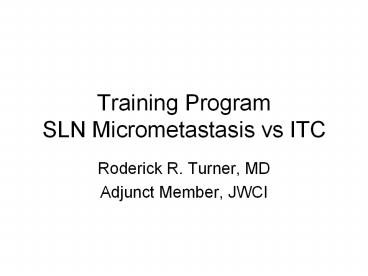Training Program SLN Micrometastasis vs ITC - PowerPoint PPT Presentation
1 / 27
Title:
Training Program SLN Micrometastasis vs ITC
Description:
Training Program SLN Micrometastasis vs ITC Roderick R. Turner, MD Adjunct Member, JWCI – PowerPoint PPT presentation
Number of Views:99
Avg rating:3.0/5.0
Title: Training Program SLN Micrometastasis vs ITC
1
Training Program SLN
Micrometastasis vs ITC
- Roderick R. Turner, MD
- Adjunct Member, JWCI
2
Introduction
- ITC and micrometastasis are distinguished on the
basis of the greatest dimension of the largest
cluster of tumor cells. - Each cluster or single cell is measured
separately. - The number of clusters or single cells does not
change categorization but, in clinical practice,
an explanatory comment may be added to a report. - Infrequently, small volume axillary disease may
be seen only in perinodal soft tissue or afferent
lymphatics this is regarded as nodal metastasis
and classified, as above, by cluster size.
3
Definitions - Cluster
- A cluster is a confluent focus of tumor cells
touching other tumor cells. This is determined
from the two-dimensional image of the microscopic
section. - Clusters or cells separated by a single benign
cell or a spatial gap are measured as separate
clusters, except when fibroblastic reaction to
the tumor cells has caused the separation.
4
Definitions - Measurements
- Measurements are determined by the greatest
dimension of the largest tumor cell cluster.
Single cells are measured separately. A known
field diameter (or ocular micrometer) should be
utilized for consistent and reliable
categorization. - Measurements are made solely from the
two-dimensional plane(s) of section(s) examined,
H-E or IHC. In clinical practice, deeper sections
and IHC are available options for further
evaluation. - Do not use the distance that separate clusters
span, sum measurements of multiple clusters, or
count/estimate tumor cell numbers.
5
Definitions Isolated Tumor Cells
- Small cluster(s), largest cluster not greater
than 0.20mm. - Single cells, as in the dispersed lobular
pattern, represent ITC densely crowded cells
when contiguous/touching are measured and
classified by the largest group of
contiguous/touching cells. - A single cell may qualify as ITC, but only when
cytologic and microanatomic features are
supportive of a carcinoma cell. This may include
a strongly positive immunoreaction. Cellular
debris and contaminants are excluded. - Mitotic activity (proliferation) is not
considered. - Microanatomic location is not a factor in
classification ITC may be found in nodal
parenchyma, capsular or subcapsular spaces, or
extranodal/afferent lymphatic vessels.
6
Definitions - Micrometastasis
- Largest cluster or confluent focus is greater
than 0.20mm, but no greater than 2.0mm. - Usually seen in nodal parenchyma but,when found
in perinodal tissue, it is classified as for
nodal disease based on size of deposit. - For borderline or indeterminate findings, at the
two ends of this spectrum, select the lower N
classification.
7
TC 1 (1 of 2) Mostly ITC clusters,
micrometastasis on right. See next.
8
TC1 (2 of 2) Small contiguous micrometastasis,
0.25mm
9
TC2 (1 of 2) Clusters are separated by
fibroblastic reaction this is a small
macrometastasis, 3.0mm. See next for better
detail.
10
TC2 (2 of 2) The clusters are separated by
fibroblastic reaction largest dimension seen on
previous slide (macrometastasis) is appropriate
11
TC3 Small micrometastasis, 0.35mm, and other
ITC clusters
12
TC4 (1 of 2) Lobular carcinoma, mostly single
ITC. Upper right shows dense crowding. See next.
13
TC4 (2 of 2) Contiguous grouping of touching
tumor cells measures 0.22mm and qualifies as
micrometastasis
14
TC5 Small micrometastasis, 0.22mm, and ITC
clusters
15
TC6 (1 of 2). Few clusters of ITC in nodal
parenchyma. See next.
16
TC6 (2 of 2). Multiple ITC clusters in nodal
parenchyma, largest 0.20mm.
17
TC7. Multiple tiny clusters and a poorly
cohesive, but contiguous, one at upper left.
Small micrometastasis, 0.23mm.
18
, TC8 (1 of 2) Tumor cell clusters in perinodal
soft tissue/capsule with fibroblastic reaction.
Micrometastasis 1.5mm. See next.
19
TC8 (2 of 2). Closer view of fibrotic reaction
between clusters.
20
TC9 (1 of 2) Tubular pattern. Multiple clusters
of ITC.
21
TC9 (2 of 2). Largest ITC cluster 0.16mm
22
TC10. Single cell, strongly CK-IHC (), 3x
diameter of lymphocytes. Minimally qualifies as
ITC
23
TC11. ITC, 3 cells, in parenchyma.
24
TC12. Many ITC clusters and single cells.
25
TC13. Several clusters of ITC, largest approx
0.09mm.
26
TC14. Multiple clusters of ITC in subcapsular
sinus.
27
END































